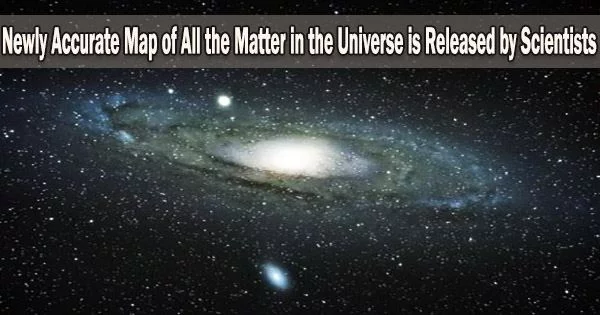Mapping all the matter in the universe is a challenging task that requires data from multiple sources, including astronomical observations and simulations. Currently, there are various maps of the large-scale structure of the universe, but they are limited by multiple factors such as observational resolution and the ability to detect different types of matter.
Sometimes to know what the matter is, you have to find it first.
The planets, stars, and galaxies that we know and love today were created throughout time as a result of stuff being thrown outward at the beginning of the universe. Today, scientists may attempt to grasp the forces that influenced the universe’s evolution by meticulously creating a map of that stuff.
A group of scientists, including several with the University of Chicago and Fermi National Accelerator Laboratory, has released one of the most precise measurements ever made of how matter is distributed across the universe today.
Combining data from two major telescope surveys of the universe, the Dark Energy Survey and the South Pole Telescope, the analysis involved more than 150 researchers and is published as a set of three articles January 31 in Physical Review D.
The investigation shows, among other things, that matter is not as “clumpy” as we would anticipate based on our current best model of the cosmos, which adds to a body of evidence indicating there may be something lacking from our current best model.
Cooling and clumps
About 13 billion years ago, the Big Bang produced all the matter in the universe in a brief period of extreme heat. Since then, this matter has been expanding outward, cooling, and clumping as it does so. Scientists are highly interested in following the journey of this matter because they can try to replicate what happened and what forces had to be at work by seeing where it all ended up.
It seems like there are slightly less fluctuations in the current universe than we would predict assuming our standard cosmological model anchored to the early universe.
Eric Baxter
The first step is collecting enormous amounts of data with telescopes.
In this study, scientists combined data from two very different telescope surveys: The South Pole Telescope, which searches for the minute remnants of radiation that are still making their way across the sky from the very beginning of the cosmos, and the Dark Energy Survey, which studied the sky for six years from a hilltop in Chile.
Combining two approaches to observing the sky decreases the likelihood that the outcomes will be tainted by a mistake in one of the measuring techniques.
“It functions like a cross-check, so it becomes a much more robust measurement than if you just used one or the other,” said UChicago astrophysicist Chihway Chang, one of the lead authors of the studies.
In both cases, the analysis looked at a phenomenon called gravitational lensing. As light traverses the cosmos, it may experience modest bending as it passes by galaxies and other objects with strong gravitational pull.
This technique captures both ordinary matter and dark matter, a mysterious kind of matter that we have only discovered because of its gravitational effects on ordinary matter.
The scientists were able to determine where all the matter in the universe ended up by carefully analyzing these two sets of data. According to the authors, it is more accurate than earlier measures since it reduces the range of potential outcomes for how this substance came to be.
The majority of the findings were in perfect agreement with the universe’s best theory as it is now understood.
However, there are also indications of a crack that has already been identified by other research.
“It seems like there are slightly less fluctuations in the current universe, than we would predict assuming our standard cosmological model anchored to the early universe,” said analysis coauthor and University of Hawaii astrophysicist Eric Baxter (UChicago PhD’14).
That is, if you construct a model using all the established physical principles and extrapolate readings from the beginning of the universe forward in time, the results will differ significantly from what we can observe in the world around us right now.
Specifically, today’s readings find the universe is less “clumpy” clustering in certain areas rather than evenly spread out than the model would predict.
The results are not yet at the statistical level that scientists believe to be unshakeable, but if further investigations find the same results, it may indicate that there is something lacking from our current understanding of the cosmos. That will take further study.
However, the analysis is significant since it combined data from two quite distinct telescope surveys to produce relevant information. As more powerful telescopes go online over the coming decades, this approach is highly expected for the field of astrophysics, yet few have actually been implemented.
“I think this exercise showed both the challenges and benefits of doing these kinds of analyses,” Chang said. “There’s a lot of new things you can do when you combine these different angles of looking at the universe.”
The University of Chicago Kavli Associate Fellow Yuuki Omori was also a lead co-author for the papers. The South Pole Telescope is primarily funded by the National Science Foundation and the Department of Energy and is operated by a collaboration led by the University of Chicago.
The National Science Foundation, the Department of Energy, and several organizations from around the world provided funding for the multinational partnership known as the Dark Energy Survey, which was managed by Fermi National Accelerator Laboratory.





